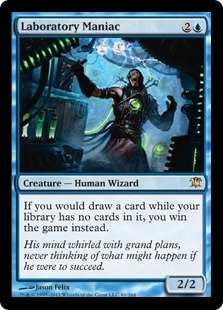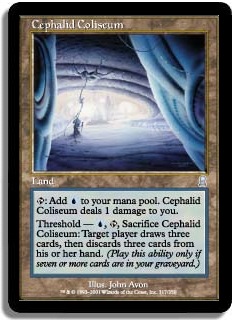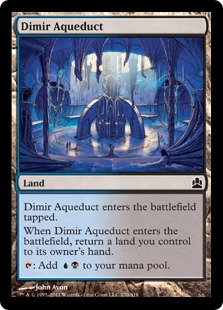Warning: This article is about Dredge and may contain too many Laboratory Maniac puns for the average Magic player!!!
One of the most polarizing decks in Magic history has to be Dredge. People hate this deck with such a passion that I honestly can’t help but constantly run it. It feels like I am constantly trolling every Vintage tournament when I play Dredge, and people HATE losing to it. They hate losing to it so much that some people even over sideboard for it. Some people will play ten sideboard cards just for Dredge.
So what if I made a new Dredge deck, where typical Dredge hate cards (Leyline of the Void, Yixlid Jailer, Tormod’s Crypt, etc.) were rendered basically useless? If successful, it would basically continue to piss people off even more…so why not give it a shot…?
I entered my Dredge Laboratory to begin brewing a deck only a maniac would play….
Enter Laboratory Maniac….
If you would draw a card while your library has no cards in it, you WIN the game instead.
I can now win the game without even attacking my opponent now, granted I can meet the conditions needed. I literally don’t need to interact with my opponent whatsoever. I don’t need to necessarily bring stuff back from my graveyard, and I don’t care what or what isn’t in my graveyard. I get to basically permanently troll Dredge haters if I can get this thing on board and operating fast enough. Let’s see what we can do.
Here is the biggest conundrum with this deck; you’re going to sacrifice speed, especially game one, for the ability to be near immune to typical Dredge hate cards. The current popular version of Dredge, Sun Titan Dredge, kills your opponent in about two turns. The version I will be discussing, which utilizes Laboratory Maniac, will win you the game in about four turns. While it may not seem big, only a two-turn difference, in Vintage that is a monstrous advantage you are now giving your opponent. One that I am not 100% sure is worth it at this point in time. The tradeoff is that Laboratory Maniac Dredge is more resilient in your post-board games, thus allowing a game one loss to not be a backbreaker.
Most Dredge decks need to win game one because playing games after sideboarding drastically changes your win percentages for games two and/or three. Cards like Leyline of the Void, Yixlid Jailer, Pithing Needle, Tormod’s Crypt, etc. can really slow or completely shut down your game plan. I needed to find away to simply ignore these cards in games two and three, but how?
This is one of my first lists with Laboratory Maniac:
Creatures (27)
- 1 Flame-Kin Zealot
- 4 Golgari Grave-Troll
- 3 Golgari Thug
- 4 Stinkweed Imp
- 4 Narcomoeba
- 3 Fatestitcher
- 4 Bloodghast
- 3 Sun Titan
- 1 Laboratory Maniac
Lands (12)
Spells (21)

I wanted to keep the Sun Titan engine for speed purposes, as well as adding the Probes and Breakthroughs for that extra push. Gitaxian Probe proved to be huge throughout testing because you needed to make sure your Cabal Therapy would hit something. The main reason for this is because since you are operating at a slower rate, you need to make sure you are slowing down your opponent. I kept the Flame-Kin Zealot kill as an alternative to help race your opponent. After getting some games in with this build, I realized that I was far from anything that would be tournament worthy. There were numerous problems with this build in execution and design.
The first problem was that you had no reliable way to get Bazaar of Baghdad without Serum Powder. You needed Bazaar of Baghdad in order to help maintain speed and make your Fatestitchers actually useful. The second problem was by the time you would win with Laboratory Maniac, you had enough to just kill you opponent outright with a Ham Sandwich…or Flame-Kin Zealot.
One of the biggest problems I had with the deck is I would just kill them turn 2-3 anyway with my Zombie army, rendering the Laboratory Maniac kill useless and wasting spots. If I wanted a Laboratory Maniac version of Dredge, I would have to fully commit to it as my win condition, rather than just having it as an alternative.
I began to brew my second version of the deck. I knew that in order to commit to Laboratory Maniac I would have to cut a lot of key cards from Dredge. Bridge from Below and Flame-Kin Zealot, two of the strongest cards in the deck wouldn’t make the cut?!?!?! Only a maniac would do this… That’s just what I was going to do. I also knew I wanted Serum Powder back into the deck in order to help reliably get Bazaar of Baghdad.
Creatures (27)
- 4 Golgari Grave-Troll
- 3 Golgari Thug
- 4 Stinkweed Imp
- 4 Narcomoeba
- 3 Fatestitcher
- 4 Bloodghast
- 3 Sun Titan
- 2 Laboratory Maniac
Lands (12)
Spells (21)

This version of the deck was testing fine. It was fast enough maindeck to compete with a lot of the format. It also had the alternative win condition of beating down with Sun Titans if need be. Sun Titan could also return a Laboratory Maniac from the graveyard, which is one of the reasons I still kept the Sun Titan engine in this version. The flaws with this build I felt were with games two and three. I couldn’t find a reasonable sideboard for this deck without having to worry about Leyline of the Void and Yixlid Jailer. In order to beat these two cards, I had to first come up with a way to get three mana in order to cast my Laboratory Maniac to ensure he made it onto the battlefield. Then find away to empty my library fast enough under a hate card.
I knew that this would call for some radical changes that only a maniac would consider, but for the deck to be that powerful against its two biggest foes, the cost seemed worth it. I went back into the laboratory to brew my next version of the deck. First I wanted to tackle the problem of getting Laboratory Maniac on the battlefield through hate. I looked to solve this problem by adding lands to the deck to help reach three mana to cast Laboratory Maniac.
I wanted something that would be useful outside of just adding mana, something that could even potentially help me dredge through my deck. The first three lands that popped into my mind were Cephalid Coliseum, Petrified Field, and Riftstone Portal. All three had uses that I could utilize with this version of Dredge with Cephalid Coliseum being the most obvious one.
Not only did it help by tapping for mana, but if I did assemble any graveyard games two and/or three, it would actually help lead me to victory thanks to its threshold ability. The real added bonus was that with the extra land count, Cephalid Coliseum was good enough to make it into the maindeck, as I could see the threshold ability being very relevant game one also. Petrified Field and Riftstone Portal were also considered, but for more of a supporting cast role.
Both provided extra mana, but in different ways. Petrified Field was probably the most useful as it could serve multiple purposes. Its ability to actually tap for mana and get back any land card from your graveyard is huge. You could return Bazaar of Baghdad to further push you to the end of your library; you could get City of Brass, Undiscovered Paradise, or Cephalid Coliseum to help get the right colored mana, and it could return a land just to help you trigger landfall with your Bloodghasts to set up Dread Returns.
Riftstone Portal helps ensure that all of your lands tap for mana; I am looking at you, Bazaar of Baghdad…The problem is that it only works when it is in your graveyard. It is nice for game one, but I found that you often don’t need to worry about hardcasting Laboratory Maniac game one, thus defeating the purpose of its inclusion. It appeared I was set on what lands I was going to be playing now with City of Brass, Cephalid Coliseum, Undiscovered Paradise, and Petrified Field…until I decided to go off the deep end.
Enter…
“WHAT?!?! Are you f***ing kidding me?!?!”
That is probably a lot of people’s reactions to this card. I also believe a lot of people will just stop reading at this point and let the maniac (me) brew in his laboratory by himself. If by chance you are still reading this, I will continue.
This land accomplishes some of the things that this deck is looking for. First it helps us reach certain mana thresholds we will be looking for in post-boarded games. Second it returns a land back to our hand, which will help us fuel Bloodghasts, our main triggers for Dread Return, and it’s even on color.
Looking at the deck at this point in the process, we can begin to make some radical changes, which I expected with this version of the deck.
Creatures (23)
- 4 Golgari Grave-Troll
- 2 Golgari Thug
- 4 Stinkweed Imp
- 4 Narcomoeba
- 3 Fatestitcher
- 4 Bloodghast
- 2 Laboratory Maniac
Lands (17)
Spells (20)

With the extra mana in the deck, I began to add some actual spells in the way of Ancestral Recall and the spell that plays best with Laboratory Maniac, Demonic Consultation. Using Demonic Consultation to name a card that is not in your deck is the quickest way to empty your library. Best used while Laboratory Maniac is on board and during your upkeep or when you can also activate Bazaar of Baghdad.
I also decided that bringing back Fatestitcher was probably the way to go with the extra land count. Undiscovered Paradise wasn’t cutting it anymore because I wanted to make sure in post-boarded games I could get to three mana as fast as I could while playing spells. The tempo loss from Undiscovered Paradise is why it didn’t make the cut in this deck. If I did want to have another rainbow land it would be Gemstone Mine.
With this 60, I felt confident that I could begin construction on the sideboard for this monstrosity. As I said, before we are sacrificing the deck’s game one win percentage to be next to immune against typical Dredge hate. Also, as I go through the sideboard, a lot of the maindeck options we chose will make more sense, such as the Dimir Aqueduct.
2 Laboratory Maniac
1 Sacred Guide
4 Divining Witch
1 Mox Jet
1 Spoils of the Vault
1 Vampiric Tutor
2 Chain of Vapor
2 Gemstone Mine
1 Imperial Seal
There is a lot going on in these 15 cards. We are trying to establish a clear plan in the post-board games that completely ignores our opponent’s hate cards.
The sideboard plan is:
+ Everything in the SB
-1 Lion’s Eye Diamond
-3 Fatestitcher
-4 Gitaxian Probe
-1 Dakmor Salvage
-2 Golgari Thug
-3 Dread Return
-1 Bloodghast
Your game plan is now shifted; you are actually looking to play spells as your opponents mulligan into sufficient sideboard hate. Divining Witch, Sacred Guide, and Spoils of the Vault (use with caution) are essentially your additional Demonic Consultations. These cards can help kill your library during your upkeep or in response to a Bazaar activation to help insure Laboratory Maniac wins it for you on the spot. You also have extra mana and tutors now to help search for and play your win condition. Dimir Aqueduct has proved useful post-board, especially when your only land is Bazaar of Baghdad and you are stuck with a Divining Witch in hand. The thing to remember also is that you can name Laboratory Maniac with your Consultation effects that aren’t named Sacred Guide to help assemble your combo.
Now that they have effectively “junked” up their decks with sideboard hate cards, the path to victory is a little easier now. Leyline of the Void and Yixlid Jailer don’t really bother you, as your Bazaar of Baghdad is now a draw engine rather than the entire engine for the deck. I feel really confident with this 75’s ability to beat down on the blue decks. The problem with the deck now is dealing with Workshop decks, for which nowhere in the 75 do you have answers or a solid game plan.
This leads me to my current irritation of the deck.
Creatures (24)
- 4 Golgari Grave-Troll
- 2 Golgari Thug
- 4 Stinkweed Imp
- 4 Narcomoeba
- 3 Fatestitcher
- 4 Bloodghast
- 1 Sun Titan
- 2 Laboratory Maniac
Lands (14)
Spells (22)

I added Ichorid and Bridge from Below back to the 75 for a couple of reasons. It tips to your opponent that you can be committed to the graveyard; you force them to deal with it by bringing in the traditional hate cards. Also against Workshop strategies, resolving three-CMC spells is simply not realistic with this deck, so I decided to go with the traditional grind them out strategy Dredge uses against the archetype. You now have two lines of attack against Workshop decks, Laboratory Maniac and Zombie beatdown. The addition of Laboratory Maniac allows you to run into their typical hate cards, Tormod’s Crypt and Relic of Progenitus, as an alternative to getting there with the Zombie masses. Sun Titan also returns with this version since I found myself with extra creatures to sacrifice to Dread Return. Sun Titan can help fuel the deck much in the way it fuels the regular Sun Titan Dredge decks, but remember to board him out when you’re using the Sacred Guide plan…
The deck is now similar to Minus 6 aka Worldgorger Dragon because you can now essentially pick and choose your poison in games two and three. You can opt to go with the traditional grind them out style currently utilized if you feel they try to get cute and not bring in traditional hate cards. You also have the option to go with a build games two and three that pretty much ignores traditional Dredge hate.
Here are some of the options you have for sideboarding.
Standard Sideboard Plan
+ 2 Laboratory Maniac
+1 Petrified Field
+1 Sacred Guide
+4 Divining Witch
+ 1 Dimir Aqueduct
+ 1 Vampiric Tutor
+ 2 Gemstone Mine
-3 Fatestitcher
-4 Gitaxian Probe
-2 Bridge from Below
-1 Sun Titan
-2 Dread Return
Here you still have the option for some Zombie beats and/or a Dread Returned Laboratory Maniac by keeping some of the Bridge from Belows in. Also you move into your game plan of looking to utilize your Demonic Consultation effects as well as casting a Laboratory Maniac.
Against Workshops
+ 3 Ichorid
+ 2 Gemstone Mine
+ 1 Petrified Field
+ 1 Laboratory Maniac
-3 Fatestitcher
-4 Gitaxian Probe
This is the plan I would look to utilize against Workshops. For the most part, Dread Return essentially being “free” is one of the “easier” spells to play under sphere effects deployed by Workshop decks. With the added land count, this is one of the options you now have. Most Workshop decks use Crypt abilities to battle Dredge, which means that we can still get the dredging on without having to worry about building an army thanks to Laboratory Maniac. If they do get rid of your Laboratory Maniacs before you can get one on the battlefield you can easily transition to beating down with Zombies also.
Depending what you believe your opponents are doing, the sideboard strategies can certainly be tweaked. Maybe you feel they are going to board out some Dredge hate game three. You can counter back by bringing in the extra Bridge from Belows. Options like this allow you to play some mind games with your opponent. Overall the 75 may need some numbers tweaked further, but I feel it is really close to a completed deck. You now have a number of different options when it comes to sideboarding, which can help keep your opponents off guard. Only time will tell if this version of Dredge will be able to compete at a high level like previous versions have, but I believe that this is a step in the correct direction for it.
–Mark Hornung
@womba_ on Twitter





